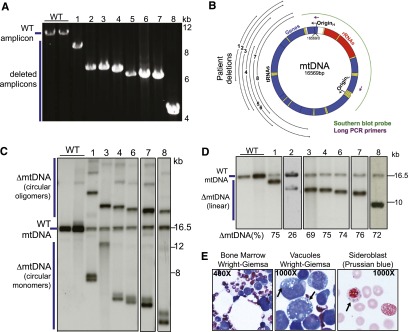Figure 1.

mtDNA analysis identifies 8 patients with PS in a cohort of DBA patients. (A) Long PCR, showing the preferential amplification of deleted mtDNA fragments from 8 patients in the DBA cohort, relative to amplification of wild-type (WT) mtDNA. (B) Map of the human mitochondrial genome, with genes (blue), transfer RNAs (tRNAs; yellow), ribosomal RNAs (rRNAs; red), and origins of DNA replication for heavy (H) and light (L) strands indicated. The extent of mtDNA deletions and corresponding patient numbers are shown by the black lines. Purple arrows represent location of the long PCR primers. Southern blot probe used in panels C and D is indicated in green. (C) Southern blot analysis of peripheral blood DNA from patients and normal controls, cut with BbvCI. WT mtDNA shows the expected, 16.5-kb linearized fragment. Deleted mtDNA (ΔmtDNA) remains uncut and migrates as circular monomeric and oligomeric species. The lanes shown are from the same blot, rearranged to match the order of patients in the text. Sufficient peripheral blood DNA was not available from patients 2 and 5. (D) Southern blot analysis of peripheral blood DNA from patients and normal controls cut with NheI or ClaI to linearize all species of mtDNA. The proportion of deleted mtDNA (ΔmtDNA [%]; ie, heteroplasmy) is shown for each sample. The lanes shown are from 3 different blots, arranged to match the order of patients in the text. Sufficient peripheral blood DNA was not available from patient 5. (E) Bone marrow evaluation of patient 4, showing classic features of PS. Wright-Giemsa stain of bone marrow showing mild hypocellularity and vacuoles in precursors (left; ×40 objective). Magnified image of vacuoles (arrows) in myeloid precursors (center; ×100 oil-immersion objective). Prussian blue stain (for iron) of bone marrow aspirate, showing a ringed sideroblast (arrow) (right; ×100 oil-immersion objective).
